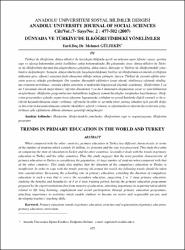| dc.contributor.author | Gültekin, Mehmet | |
| dc.date.accessioned | 2019-10-19T19:57:28Z | |
| dc.date.available | 2019-10-19T19:57:28Z | |
| dc.date.issued | 2007 | |
| dc.identifier.issn | 1303-0876 | |
| dc.identifier.uri | http://www.trdizin.gov.tr/publication/paper/detail/TnpFMU9EVTE= | |
| dc.identifier.uri | https://hdl.handle.net/11421/15255 | |
| dc.description.abstract | Türkiye’de ilköğretim, dünya ülkeleri ile karşılaştırıldığında gerek on milyonu aşan öğrenci sayısı, gerekse yapı ve işleyişi bakımından farklı özelliklere sahip bulunmaktadır. Bu çalışmada, önce, dünya ülkeleri ile Türkiye’de ilköğretimin durumu karşılaştırılmaya çalışılmış, daha sonra, dünyada ve Türkiye’de ilköğretimdeki yönelimlere değinilmiştir. Sonuçta, dünya ülkeleriyle karşılaştırıldığında Türkiye’de ilköğretimin en önemli özelliğinin nüfusuna göre, öğrenci sayısının fazla olmasının olduğu ortaya çıkmıştır. Ayrıca, Türkiye’de zorunlu eğitim süresinin yetersiz olduğu görülmüştür. Öte yandan, dünyadaki eğilimlere koşut olarak, okulöncesi eğitimde okullaş- ma oranının artırılması; zorunlu eğitim süresinin ortaöğretimi kapsayacak biçimde uzatılması¸ ilköğretimin 2 ya da 3 basamak olarak öngörülmesi; öğretim döneminin 3 ya da 4 dönemden oluşmasının yarar ve sınırlılıklarının araştırılması; ilköğretim programlarının bakanlıktan bağımsız uzman kuruluşlar tarafından hazırlanması; ilköğretim programları yoluyla yaşam boyu öğrenme kapsamında, istihdam ve sosyal katılımla ilişkili yetenek ve becerilerin kazandırılmasına önem verilmesi; öğrencilerin etkin ve sorumlu birer yurttaş olmaları için gerekli değer ve becerilerin kazandırılmasına yönelik etkinliklere ağırlık verilmesi ve öğretmenlerin öğretim becerilerinin geliştirilmesi gibi eğilimlerin dikkate alınması gerektiği anlaşılmıştır. | en_US |
| dc.description.abstract | When compared with the other countries, primary education in Turkey has different characteristic in terms of the number of students which extends 10 million, its structure and the way it is processed. This study first aims at comparing the state of education in Turkey and the other countries. Secondly it deals with the trends in primary education in Turkey and the other countries. Thus this study suggests that the most peculiar characteristic of primary education in Turkey is considering the population, its huge number of students when compared with that of the other countries. This study also implies that the duration of the compulsory education in Turkey is insufficient. In order to cope with the trends growing all around the world, the following trends should be taken into consideration: Increasing the schooling rate in primary education, extending the duration of compulsory education in such a way that it covers the secondary education, suggesting 2 or 3 stage primary education, studying the benefits and boundaries of 3 or 4 term training period, having the primary education programme prepared by the expert institutions free from ministry of education, attaching importance to acquiring talent ability related to life long learning, employment and social participation through primary education programme, attaching importance to activities which enable students to become an active and responsible person, and developing teachers' teaching skills. | en_US |
| dc.language.iso | tur | en_US |
| dc.rights | info:eu-repo/semantics/openAccess | en_US |
| dc.subject | Sosyal Bilimler | en_US |
| dc.subject | Disiplinler Arası | en_US |
| dc.title | Dünyada ve Türkiye'de İlköğretimdeki Yönelimler | en_US |
| dc.title.alternative | Trends in Primary Education in the World and Turkey | en_US |
| dc.type | article | en_US |
| dc.relation.journal | Anadolu Üniversitesi Sosyal Bilimler Dergisi | en_US |
| dc.contributor.department | Anadolu Üniversitesi, Eğitim Fakültesi, Temel Eğitim Bölümü | en_US |
| dc.identifier.volume | 7 | en_US |
| dc.identifier.issue | 2 | en_US |
| dc.identifier.startpage | 477 | en_US |
| dc.identifier.endpage | 502 | en_US |
| dc.relation.publicationcategory | Makale - Ulusal Hakemli Dergi - Kurum Öğretim Elemanı | en_US] |
| dc.contributor.institutionauthor | Gültekin, Mehmet | |


















